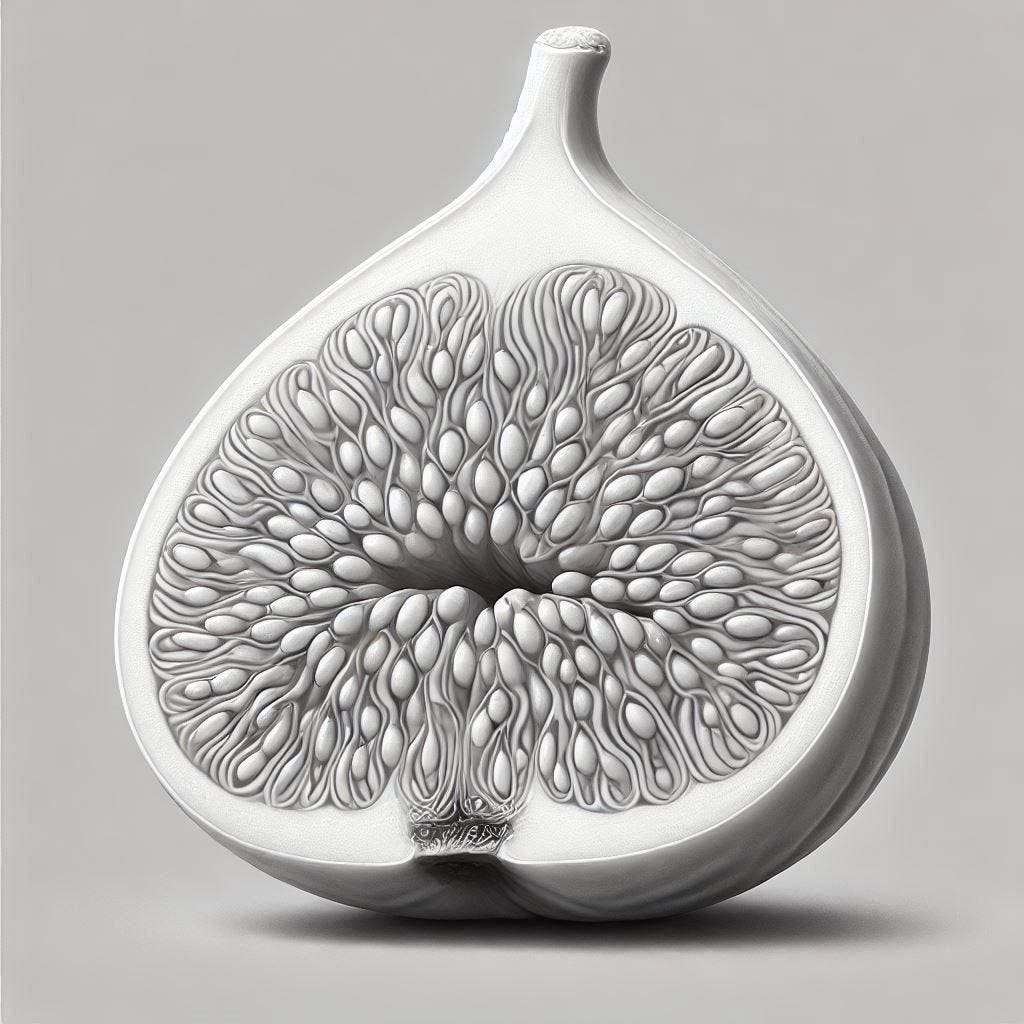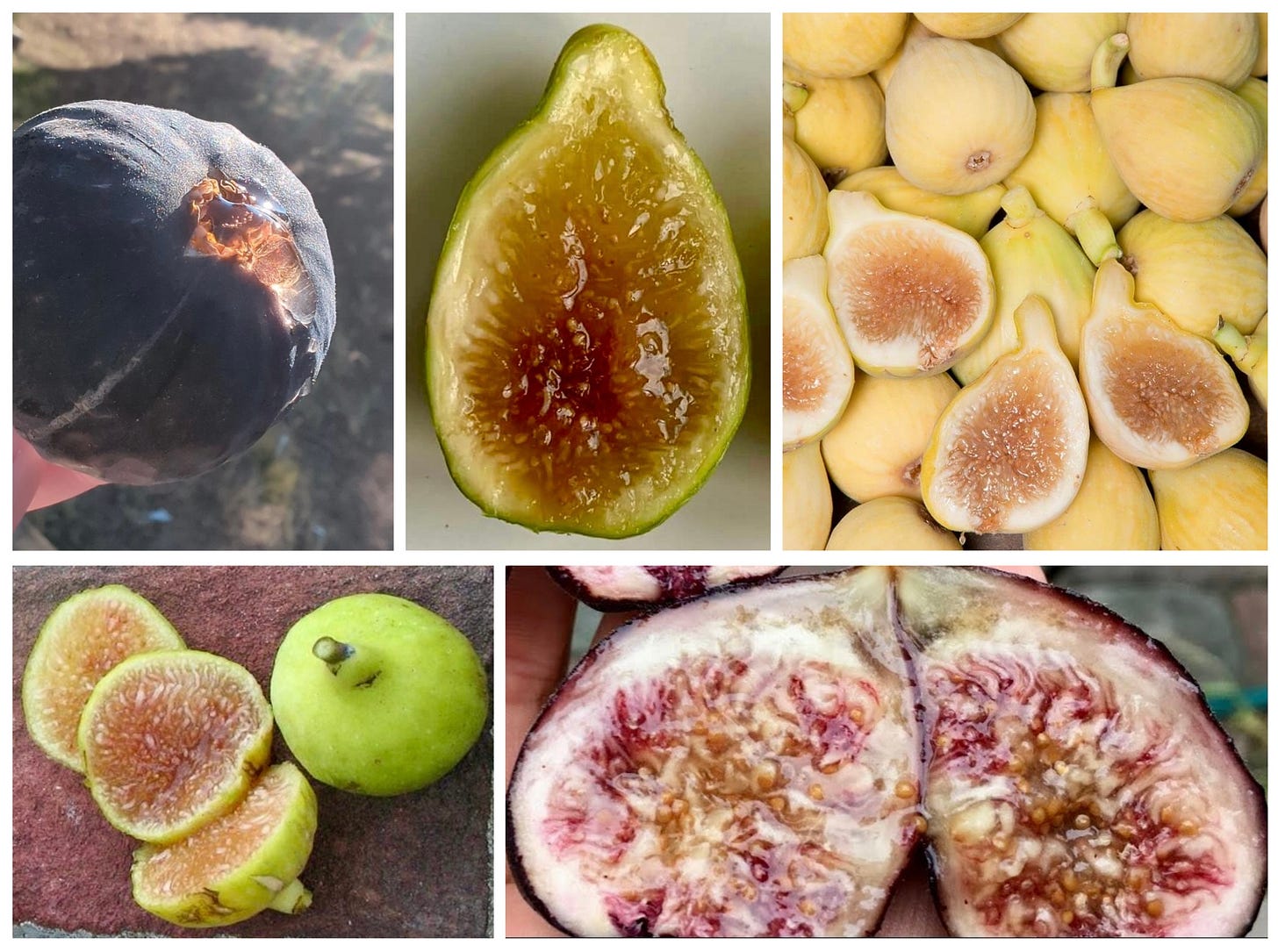What Would A White Fig Taste Like?
Does color affect our perception of fig flavors?
Does a flavor come to your mind when you look at the picture of the white fig? More than likely it actually represents an anti-flavor or a lack of any taste. Perhaps just a saltiness or a bland sugar sweetness presents itself to you, after all, that is what ‘white’ often denotes to many peoples’ minds. Would it surprise you if someone told you it tasted like the sweetest of black raspberries?
When people get into collecting figs, they can be amazed at the flavor descriptions presented by other collectors. Flavor groupings are one of the primary first aspects looked into when forming one’s collection. Figs are said to taste of strawberries, blueberries, honey, cherries, raspberries, peaches, mangos, pineapple, persimmons, apple pie, butter, and even chocolate— to name a few.
Collectors have argued for years over flavor categories and sometimes it seems like each seller or collector has their own set of flavor groupings. Is flavor defined by skin color? By pulp color? Could it be the same exact flavor only interpreted by our minds as different by the color of the fig itself?
The influence of color on taste perception has been often studied in research. Studies have been done on wine drinkers with tasteless, scentless red dye added to white wine. Without being the wiser, they describe the white wine with taste descriptors attributed to red wines. Did the color change influence them that much? It did.
Many of us like to believe that we are not easily deceived. However, our sense of taste is often fooled by our sense of sight. Color is usually the first element noticed in the appearance of a food product. We begin to associate certain colors with various types of food from the moment we first begin to eat as babies. We equate these colors to certain flavors and tastes we experience throughout life. They also indicate ripeness and freshness. For example, yellow may be expected to have a banana or lemon flavor, red can indicate sweetness, strawberries or cherries, and so on.
If the color of a food does not match our expectations, it still can influence our perception of that taste because strong color cues can override actual flavor. This is a known psychological effect companies use to their advantage when making processed foods. For example, limited edition white Skittles, which maintained their original different flavors, had people confused because they could not make out what they were tasting without the color to guide them.
Background & culture also influence our sense of taste. Blue coloring can indicate an artificial flavoring to people, but which flavor does it indicate to you? In a study by Professor Spence on two groups of people, one from the UK and one from Taiwan, participants were presented with a blue-colored drink and asked what flavor they expected the drink to have. The British group expected it to taste of raspberry whereas the Taiwanese participants expected it to taste of mint. Does this mean that a fig flavor nuance to someone in the USA is very different from someone who grew up elsewhere with a different flavor experience in life?
Caveat Emptor — The “Honey” Fig
One oft-repeated flavor category in The Figdom is “honey”. If you were to ask every collector out there what a “honey” fig is, you would get a plethora of responses. “Honey” has come to represent everything from skin color to pulp color, to taste, to syrupiness and every combination in between.
When I first started collecting figs and I heard the term “honey”, I thought that sounded delightful— a fig with the sweet, rich, unique nectar taste of honey. But I have yet to taste one “honey” fig that actually tastes like literal honey. Most often they taste like a nondescript ripe melon. So what causes them to be called “honey” figs? Is it their honey-yellow skin? Their golden honey-colored pulp? The sweet nectary drop of “honey” at the ostiole? Yes. Yes, to all of the above. The influence of the eyes is what causes them to be called “honey” figs alone in my experience, not actual taste.
I am still on the lookout for a “honey” fig that truly tastes like honey and not melon. I hope to one day find one. Because, seriously, does that not sound good? But in the meantime, we have “honey” figs with quotation marks because they are not truly honey tasting no matter what the yellow flesh and skin color may indicate to us. It’s just that according to research and all things indicative of the human experience, I may have to locate that variety by tasting the figgy contenders blindfolded lest the color deceives my palate.
Another Sight-Taste Conundrum
What do you imagine the fig pictured below to taste like? If you answered like a strong dark berry explosion on your tongue, you would not be alone. Multiple collectors have described this variety as having a strong berry taste. One collector though described it as a “sugar” fig, meaning not berry but more mild “figgy” flavored. How can that be, you might ask? I certainly asked!
I racked my memory of tasting this variety and thought, surely, he must be tasting a different fig than I. Most definitely I thought I remembered it tasting strongly of berries. In a quest to verify the veracity of this statement, I tasted one of my own a few weeks later. What flavors did my tingling, vibrating tastebuds taste? A sugar fig. 🤯
My eyes told me I must be mistaken. I tasted it again because of that. Still a sugar fig. Maybe because it’s an off-year? (Even though it was not an off year for the other collector describing it as a sugar fig.) Surely I am tasting a hint of berry in there? My brain could not reconcile the intense dark berry colors without there being a corresponding berry flavor. How does intense strawberry jammy red not taste of equally intense berry flavors?
It led me to wonder, how many figs are described with their delightful flavors because of the colors alone? How many different fig flavors actually exist? Do I describe a fig as “dark berry” simply because of its darker purple-berry color or because it literally tastes like dark berries?
Clearly the brain has a preconceived expectation of what a certain color is to taste like. So perhaps we are not actually tasting with our mouth alone as much as we think we are. Case in point, the collectors who described Joualle Noire as an intense berry fig. It wasn’t a berry flavor that was intense, it was the berry coloring. We eat first with our eyes after all, as the saying goes for apparent good reason.
So perhaps a white fig just tastes like a fig, until you give it color.








You touched on something important….Research suggests that the way colors are named in language affects how easily individuals can recall and differentiate them. This supports the idea that language influences perception and cognitive processes.This illustrates that human perception is flexible and can be shaped by cultural and linguistic factors.